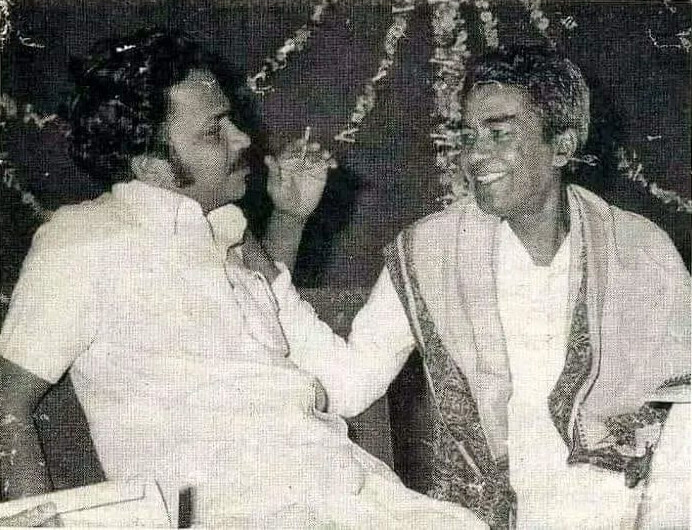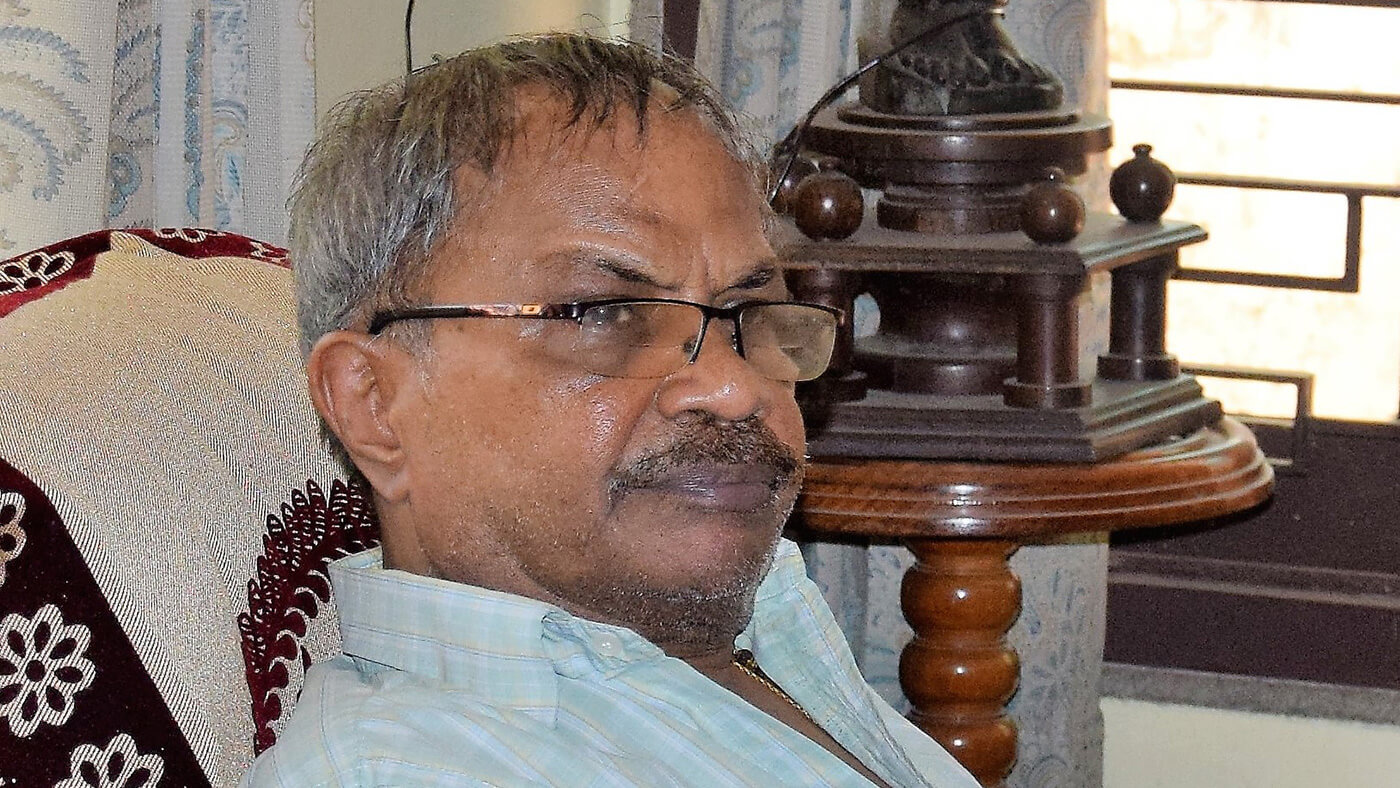“Nirmalyam” (The Offering), a 1973 creation of M.T. Vasudevan Nair, a revered cultural figure in Kerala, stands somewhat in the shadows of the celebrated New Wave Renaissance of Malayalam cinema in the 1970s. Despite MT (popularly called) significant stature as a writer, especially noted as he turned 90 in July 2023, this particular film hasn’t received the widespread acclaim or recognition one might expect. Intriguingly, even those who meticulously document Kerala’s rich film history seem to have overlooked Nirmalyam, failing to give it its due place in the annals of Malayalam cinema’s evolution and legacy. This oversight is particularly curious given the film’s unique contributions and the high regard for MT ‘s broader body of work.
MT’s film, warmly referred to by his initials, stands as a cinematic milestone not just for its compelling story but also for its rich visual language and stunning beauty. The film masterfully captures the essence of a fading feudal village, where the rhythms of life have been disrupted by the sweeping changes of the 1950s and 60s. It’s like a vivid tapestry, weaving together the lives of these village folks, who find themselves at a crossroads of time and tradition. More than just a portrayal of societal shifts, the film delves deep into the evolving religious beliefs of the villagers, centering on an ancient temple that has stood as a silent witness to the passage of time. This temple, a cornerstone of their lives, becomes a symbol of their changing faith and traditions. MT’s film is a poignant reflection of this transformation, told through a lens that captures both the heartache of change and the enduring beauty of tradition.
Best film of the year
It’s no surprise that Nirmalyam was celebrated as the best film of the year, a distinction shared by the same esteemed jury that had honored Adoor Gopalakrishnan’s Swayamvaram as the top film of 1972. The 1973 jury, led by Romesh Thaper, included not just luminaries from the film world but also celebrated Malayalam writer O.V. Vijayan, Teji Bachan, and Dileep Padgaonkar, who later became the Editor of The Times of India. This panel of judges recognized the exceptional quality of Nirmalyam, a recognition that Swayamvaram did not receive at the state level. In Kerala, where MT’s reputation as a gifted writer and editor of a popular literary weekly was well-established, it would have been almost unthinkable for any jury to overlook his cinematic creation. Nirmalyam thus found a well-deserved place of honor in the Kerala State awards, cementing MT’s status as a filmmaker of extraordinary talent and vision.
The film’s enduring significance lies in its courageous depiction of the deep struggles faced by those devoted to their faith, particularly highlighting the life of a local Hindu temple’s deity. The film’s protagonist, a deeply committed oracle, embodies this devotion. He equates the misfortunes and the melancholy state of his village as a direct result of the villagers neglecting their temple rituals, the temple itself standing on the brink of ruin.
This oracle, a pillar of faith in the story, continually confides in his father, who was once an oracle himself but now is bedridden following a stroke. For the son, his father represents more than just a parent; he is a symbol of ‘time’ itself—immobile, yet acutely aware of every unfolding event, including the heart-wrenching betrayal by his wife as the film reaches its climax.
This narrative thread weaves a tapestry of emotions, capturing the profound impact of faith on human lives. The oracle’s unwavering belief and the resultant turmoil he faces paint a vivid picture of devotion and despair. The film, through these poignant portrayals, invites the viewer into a world where faith and reality collide, leaving an indelible emotional imprint.
In the film, MT, along with his talented team including Associate Director Azad and cinematographer Ramachandra Babu, both alumni of the prestigious FTII, brings to life some truly touching scenes. They skillfully capture the intimate moments shared between the elder oracle and his son within the dimly lit confines of their home. These scenes, reminiscent of the works of Tarkovsky, are where time seems to pause, allowing the viewers to fully immerse themselves in the emotional depth of the narrative.
In these quiet, reflective moments, the film portrays the poignant fate of two generations bound by their unwavering devotion to a local deity. The father and son, both ardent followers, have intertwined their own destinies with that of the temple, mirroring the fate of their village and its inhabitants. These scenes are crafted with a gentle yet powerful touch of empathy for respect of individuals, showcasing the deep-rooted beliefs and the legacy of devotion that passes from one generation to the next. It’s in these moments that the film not only tells a story, but also paints a picture of enduring faith and the complexities it brings to human lives.
The story takes a compelling turn with the oracle’s elder son, a representation of the third generation. Educated yet unemployed, he stands in stark contrast to his forefathers. To him, the ancestral role of the oracle is not a calling but a burden, one he finds deeply unappealing. Yet, he finds himself anchored to the village, trapped by the lack of job opportunities that would enable him to provide for his family, which relies on the increasingly scarce offerings from the temple.
In a poignant juxtaposition, the father, the current oracle played by the renowned PJ Antony, remains steadfast in his traditional role. His deep-rooted beliefs and commitment to his duties are unshakable. He tirelessly works to keep the temple rituals alive, even seeking out the local Nampoodiri to request a new priest when the old one departs. His warnings about the consequences of neglecting the local deity echo through the village, especially as a smallpox outbreak jolts the villagers into a grim realization. This narrative beautifully captures the generational divide and the struggle between upholding tradition and embracing change, set against the backdrop of a village caught in the midst of its own evolution.
As the story unfolds, the village is shaken by the outbreak of smallpox, a dire reminder to the villagers of their neglected temple deity. However, this awakening comes too late for the oracle, whose life is already steeped in turmoil. His son, unable to bear the weight of tradition and lack of opportunities, leaves the village. Meanwhile, his daughter, who had formed a connection with the new young priest, faces betrayal as the priest abandons her for a better life elsewhere, leaving her in a state of confusion and heartbreak.

The oracles plight
The oracle’s household, already strained, faces further humiliation from the local money lender, whose frequent visits for repayments become a source of shame. In a moment of despair and vulnerability, the oracle’s wife, seeking to alleviate their financial burdens, succumbs to the exploitative demands of the money lender.
For the oracle, these cascading tragedies become his breaking point. Yet, he chooses not to lash out in anger or violence. Instead, he channels his profound frustration and sense of helplessness into a powerful, ritualistic dance with a sword, intended for the welfare of his fellow villagers. In a climactic and heart-wrenching moment, he strikes his own skull with the sword, a frenzied act symbolizing his complete disillusionment. His blood, spilled on the deity, becomes a poignant testament to his despair. This tragic act leads to his demise, leaving the viewers to grapple with the depth of his anguish.
These emotionally charged scenes, filmed at a village temple in North Kerala, capture a raw intensity that resonates deeply, especially considering the current religious climate in India. PJ Antony’s portrayal of the oracle, an actor of Christian faith, is so powerful and convincing that it earned him the highest acting honors both nationally and in the state. This part of the film not only showcases his extraordinary talent but also underscores the universal themes of faith, despair, and the human condition.
The film, which largely unfolds in a tranquil, unassuming manner, culminates in a finale that is profoundly unsettling. This stark contrast in tone imbues the film with a poetic quality reminiscent of Ingmar Bergman’s Winterlight (1) from 1963. In Bergman’s film, a priest grapples with his faith against the harsh realities of life outside the church walls, his doubts mirroring those of his atheist girlfriend. Similarly, Nirmalyam explores the struggles of faith, but set against a different backdrop: a village suspended in time and poverty.
In this quiet village, the film paints a vivid picture of life where beliefs and traditions are deeply ingrained, yet the gods seem indifferent to the plight of their devotees. The villagers’ struggle with their faith in the face of adversity and the unyielding passage of time echoes a universal theme. This poignant juxtaposition of the serene village life with the tumultuous inner turmoil of its characters lends the film a depth that transcends its setting, making it a powerful narrative about the human condition and the complexities of faith in a changing world.
Capturing the period
In the decades of the 60s and 70s, the villages of India found themselves caught in a delicate dance between age-old traditions and the impending winds of change. This era, especially following the country’s independence, was marked by a gradual transformation, one that many New Wave films of the time chose to spotlight. These films, much like Satyajit Ray’s iconic Pather Panchali, turned their lenses towards the rustic landscapes of Indian villages, capturing the stark realities of life there. They painted vivid pictures of the hardships and the dire need for significant change in these rural heartlands.
M.T. Vasudevan Nair’s debut film beautifully aligns with this cinematic movement. He weaves a narrative that mirrors this period of transition, shedding light on the poignant struggles of village life. Through his storytelling, MT not only reflects the slow and painful pace of change that marked this era but also underscores the profound impact it had on the lives of people in these villages. His film is a testament to the resilience of these communities and the enduring spirit of hope amidst times of uncertainty and transformation.
In the realm of Malayalam cinema during this transformative period, films like Adoor Gopalakrishnan’s Swayamvaram(1972) and G. Aravindan’s Uttarayanam(1974) became poignant narratives. These films shared a common thread – the portrayal of educated yet jobless young individuals trying to navigate through the slow and agonizing pace of societal change. Their struggles, marked by intense uncertainty and unfulfilled aspirations, mirrored the collective experience of many during that era. MT’s Nirmalyam of 1973 joined this new wave Renaissance among Malayalam films.
These cinematic pieces were often labeled as somber and introspective, echoing the deep philosophical undertones found in the works of an Akiro Kurosawa or Ingmar Bergman. However, it’s within these dark and reflective themes that the true brilliance of creators like M.T. Vasudevan Nair shone brightest. MT, a luminary in Malayalam literature and film, harnessed these challenging times to craft stories that were not only compelling but also deeply resonant.
Nirmalyam, MT’s own contribution to this era stands as a testament to this creative flourishing during challenging times. It added a unique voice to the Malayalam film renaissance of the 1970s, embodying the era’s spirit and its poignant quest for meaning amidst the changing tides of time. In doing so, MT and his contemporaries not only captured the essence of their times but also enriched the tapestry of Indian and Malayalam cinema with their profound and introspective narratives.
Despite the evolving religious and social landscape that, over the years, has made the screening of such forthright films challenging, Nirmalyam remains a significant cultural artifact. It masterfully captures and preserves the essence of life in that era, both creatively and technically, for future generations. The film is not just a portrayal of a time long passed but a living, breathing piece of history, offering insights into a period of profound change and the timeless nature of human struggles and triumphs.
(Edited excerpts from the book “ Noon films and Magical renaissance of Malayalam cinema” by V K Cherian)




